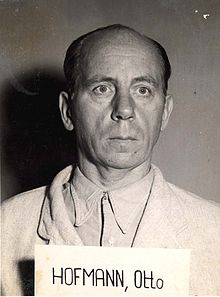- Otto Hofmann
-
Otto Hofmann 
Representative of the Race and Settlement Main Office To
The Wannsee ConferenceIn office
January 20, 1942
– March 6, 1942
(Two Meetings)Personal details Born March 16, 1896
InnsbruckDied December 31, 1982 (aged 86)
Bad MergentheimMilitary service Allegiance  Nazi Germany
Nazi GermanyService/branch SS 1931–1945
RuSHA 1940–1943Years of service 1933–1945 Rank Gruppenführer Commands Chief of the RuSHA Battles/wars World War I
World War IIOtto Hofmann (March 16, 1896 – December 31, 1982) was an Austrian SS-Gruppenführer and an official of Nazi Germany's "Race and Settlement Main Office".
Contents
Early life
Hofmann was born in Innsbruck, Tyrol. He served as a military pilot in World War I. Originally trained as a wine salesman, he joined the SS in 1931. Life Hofmann, the son of a merchant, reported after visiting the school in August 1914 as a volunteer for the First World War. In March 1917, promoted to lieutenant, he came in June of that year in Russian captivity, from which he escaped to Germany. Here he completed his pilot training before he was released in 1919 to civilian life. After short-term operation in a Freikorps[1] He was active from 1920 to 1925 in the wine wholesale, then he started his own business as a wine representative.
In April 1923, Hofmann was in the NSDAP (Member 145 729 ) and in April 1931 he was a member for the SS (Member 7646 ). From 1933 he worked full time as an SS officer. On 29 March 1933 he ran unsuccessfully in the general election.
In 1939 he was co-editor of the journal Biologist, by SS - Ancestral Heritage had been taken.[1 ] From July 1940 to April 1943, he was chief of Race and Settlement Main Office the SS In this capacity, he participated in the Germanization of the territory Poland and Soviet Union. He was responsible for the Race test, distributed as a consequence population of the occupied territories from their land and German,were located there, for the abduction of Polish children to Germany and for the SS - kin care. On the Wannsee Conference on 20 January 1942, the so-called Final Solution of the Jewish Question on the subject, had called the Hofmann Sterilization the Hybrids.
In April 1943, Hofmann was leader of the SS and the upper portion of southwest Higher SS and Police Leaders in Württemberg, Baden and Alsace. He was the commander of the prisoners in the local Military District V. He was put to trial for the Race and Settlement Main Office in March 1948. He was charged with Crimes against Humanity and War Crimes. Although Hofmann was sentenced to 25 years in prison, on 7 April 1954 he was pardoned. He was dismissed from the Prison Landsberg After that, he was a clerk in Württemberg until he died in December 1982. source: wikipedia.de
Role in the Holocaust
From 1940-43 Hofmann was head of the RuSHA (Rasse und Siedlungshauptamt – the Race and Settlement Main Office) within the SS. In this capacity he took part in the Wannsee Conference, in which members of the Nazi hierarchy discussed policies which were later enacted and led, in part, to The Holocaust. In 1943 he was transferred to Stuttgart as SS and Police Leader for South-Western Germany.
Imprisonment
In 1948 Hofmann was sentenced to 25 years in prison for war crimes, but he was pardoned in 1954. He died in Bad Mergentheim.
Fictional portrayals
In the 2001 HBO film Conspiracy, he was played by Nicholas Woodeson.
See also

This article related to The Holocaust is a stub. You can help Wikipedia by expanding it. This article about a notable individual during World War II is a stub. You can help Wikipedia by expanding it.
